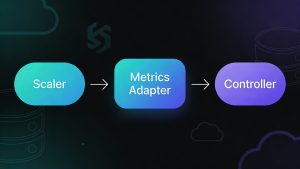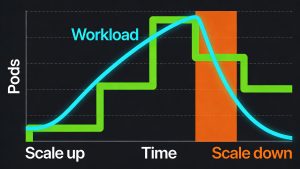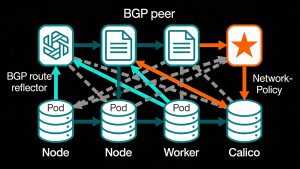In a significant leap forward for cloud infrastructure management, Amazon Web Services (AWS) has unveiled a game-changing feature for its Elastic Kubernetes Service (EKS) users. The Amazon CloudWatch Observability add-on now offers a streamlined, one-step onboarding process for EKS workloads, revolutionizing how developers and system t500_prod_administrators monitor and manage their Kubernetes environments.
The Power of One-Click Enablement
The newly introduced one-click enablement feature marks a pivotal shift in the way EKS clusters are set up and monitored. This innovative approach allows users to activate the CloudWatch Observability add-on during the cluster provisioning phase, significantly simplifying the entire process.
Integrated Insights at Your Fingertips
By enabling the CloudWatch Observability add-on with a single click, users gain immediate access to two powerful monitoring tools:
- CloudWatch Container Insights
- Application Signals
This integration provides a comprehensive view of application health and performance right from the start, eliminating the need for complex, multi-step setup procedures.
Seamless IAM Integration
One of the standout features of this update is its integration with EKS Pod Identity. This integration allows users to create a recommended IAM role for the add-on, which can be reused across multiple clusters. This approach not only saves time but also streamlines the management of permissions, reducing the potential for security misconfigurations.
A Paradigm Shift in Cluster Management
Prior to this update, setting up monitoring for EKS clusters was a multi-step process that required careful orchestration:
- Create the cluster
- Wait for the cluster to become active
- Install the CloudWatch Add-on
- Manage IAM permissions separately
This process was not only time-consuming but also prone to errors and inconsistencies.
The New Streamlined Approach
With the latest update, users can now:
- Create their clusters
- Install the Amazon CloudWatch Observability add-on simultaneously
- Launch clusters with observability enabled from the outset
This new approach ensures that observability telemetry is available in CloudWatch immediately, allowing for faster insights and more proactive management of EKS environments.
Leveraging CloudWatch for Proactive Management
The integration of CloudWatch Application Signals and CloudWatch Container Insights provides users with a powerful toolkit for managing their EKS workloads.
Curated Dashboards
Users can take advantage of curated dashboards that offer:
- Real-time insights into application performance
- Detailed metrics on container health
- Comprehensive views of cluster resources
These dashboards empower users to:
- Identify and isolate anomalies quickly
- Troubleshoot issues more efficiently
- Take proactive measures to prevent application disruptions
By leveraging these tools, organizations can significantly reduce downtime and improve overall application reliability.
Wide Availability and Easy Implementation
The CloudWatch Observability add-on is now accessible across all commercial AWS Regions, including the AWS GovCloud (US) Regions. This wide availability ensures that organizations around the globe can benefit from these enhanced monitoring capabilities.
Multiple Implementation Options
To cater to different user preferences and workflows, AWS has made the add-on available through various channels:
- Amazon EKS console
- AWS APIs
- AWS Command Line Interface (CLI)
- AWS CloudFormation
This flexibility allows teams to integrate the add-on into their existing infrastructure management processes seamlessly.
The Impact on DevOps Practices
The introduction of this streamlined onboarding process for the CloudWatch Observability add-on is set to have a significant impact on DevOps practices within organizations using EKS.
Enhanced Efficiency
By reducing the time and effort required to set up monitoring for EKS clusters, DevOps teams can:
- Focus more on developing and improving applications
- Respond faster to issues and anomalies
- Implement more robust and consistent monitoring across all clusters
Improved Collaboration
The unified view provided by the CloudWatch Observability add-on facilitates better collaboration between development and operations teams. With shared dashboards and metrics, teams can:
- Communicate more effectively about application performance
- Make data-driven decisions more quickly
- Align on priorities and resource allocation
Accelerated Troubleshooting
The immediate availability of observability data means that teams can:
- Identify issues faster
- Pinpoint root causes more accurately
- Implement fixes and improvements more efficiently
This rapid troubleshooting capability can lead to significant reductions in mean time to resolution (MTTR) for application issues.
Looking Ahead: The Future of EKS Monitoring
The launch of the one-step onboarding for the CloudWatch Observability add-on represents a significant step forward in the evolution of EKS monitoring. As AWS continues to innovate in this space, users can expect:
- Further integrations with other AWS services
- More advanced analytics and machine learning capabilities
- Enhanced customization options for dashboards and alerts
These ongoing improvements will continue to empower organizations to manage their Kubernetes environments more effectively and efficiently.
Conclusion
The introduction of one-step onboarding for the Amazon CloudWatch Observability add-on marks a significant milestone in EKS workload monitoring. By simplifying the setup process, integrating crucial monitoring tools, and providing immediate access to valuable insights, AWS has empowered organizations to manage their Kubernetes environments more effectively than ever before.As the cloud computing landscape continues to evolve, tools like the CloudWatch Observability add-on will play an increasingly crucial role in ensuring the reliability, performance, and security of containerized applications. Organizations that leverage these advanced monitoring capabilities will be well-positioned to stay ahead in the competitive world of cloud-native development and operations.
Read more such articles from our Newsletter here.



